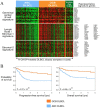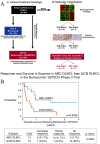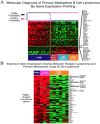Using biologic predictive factors to direct therapy of diffuse large B-cell lymphoma
- PMID: 23610613
- PMCID: PMC3629761
- DOI: 10.1177/2040620712464508
Using biologic predictive factors to direct therapy of diffuse large B-cell lymphoma
Abstract
While diffuse large B-cell lymphoma (DLBCL) was once considered to be a single disease entity, recent biological insights have demonstrated that it can be divided up into at least three molecular subtypes. Gene expression profiling has revealed that DLBCL consists of a germinal center B-cell like subtype (GCB), an activated B-cell like subtype (ABC) and a primary mediastinal B-cell lymphoma subtype (PMBL). These three entities arise from different stages of B-cell differentiation and are characterized by distinct mechanisms of oncogenic activation. In GCB DLBCL, the BCL6 transcription factor may play an important role in tumor survival and treatment resistance and strategies that target this are under investigation. ABC DLBCL is characterized by high expression of target genes of the nuclear factor kappa B (NF-κB)/Rel family of transcription factors and strategies that target NF-κB are in clinical trials. PMBL is a distinct clinicopathologic entity that shares many molecular features with nodular sclerosis Hodgkin lymphoma (HL) and may benefit from dose intensity approaches and inhibition of the Janus kinases. Other biologic predictive factors such as MYC and BCL2 may be overexpressed in both the GCB and ABC subtypes and strategies that target these complexes are also being tested.
Keywords: B-cell receptor signaling; diffuse large B-cell lymphoma; gene expression profiling; germinal center; molecular subtypes; mutational analysis; nuclear factor kappa B.
Figures





Similar articles
-
ASB2 is a direct target of FLI1 that sustains NF-κB pathway activation in germinal center-derived diffuse large B-cell lymphoma.J Exp Clin Cancer Res. 2021 Nov 11;40(1):357. doi: 10.1186/s13046-021-02159-3. J Exp Clin Cancer Res. 2021. PMID: 34763718 Free PMC article.
-
The biology of human lymphoid malignancies revealed by gene expression profiling.Adv Immunol. 2005;87:163-208. doi: 10.1016/S0065-2776(05)87005-1. Adv Immunol. 2005. PMID: 16102574 Free PMC article. Review.
-
Clinical Significance of BCL2, C-MYC, and BCL6 Genetic Abnormalities, Epstein-Barr Virus Infection, CD5 Protein Expression, Germinal Center B Cell/Non-Germinal Center B-Cell Subtypes, Co-expression of MYC/BCL2 Proteins and Co-expression of MYC/BCL2/BCL6 Proteins in Diffuse Large B-Cell Lymphoma: A Clinical and Pathological Correlation Study of 120 Patients.Int J Med Sci. 2019 Apr 20;16(4):556-566. doi: 10.7150/ijms.27610. eCollection 2019. Int J Med Sci. 2019. PMID: 31171907 Free PMC article.
-
Molecular subtypes of diffuse large B-cell lymphoma arise by distinct genetic pathways.Proc Natl Acad Sci U S A. 2008 Sep 9;105(36):13520-5. doi: 10.1073/pnas.0804295105. Epub 2008 Sep 2. Proc Natl Acad Sci U S A. 2008. PMID: 18765795 Free PMC article.
-
ABC, GCB, and Double-Hit Diffuse Large B-Cell Lymphoma: Does Subtype Make a Difference in Therapy Selection?Am Soc Clin Oncol Educ Book. 2015:e449-57. doi: 10.14694/EdBook_AM.2015.35.e449. Am Soc Clin Oncol Educ Book. 2015. PMID: 25993209 Review.
Cited by
-
Voruciclib, a clinical stage oral CDK9 inhibitor, represses MCL-1 and sensitizes high-risk Diffuse Large B-cell Lymphoma to BCL2 inhibition.Sci Rep. 2017 Dec 21;7(1):18007. doi: 10.1038/s41598-017-18368-w. Sci Rep. 2017. PMID: 29269870 Free PMC article.
-
Functional imaging in combination with mutation status aids prediction of response to inhibiting B-cell receptor signaling in lymphoma.Oncotarget. 2017 Aug 24;8(45):78917-78929. doi: 10.18632/oncotarget.20551. eCollection 2017 Oct 3. Oncotarget. 2017. PMID: 29108275 Free PMC article.
-
Variability in DNA methylation defines novel epigenetic subgroups of DLBCL associated with different clinical outcomes.Blood. 2014 Mar 13;123(11):1699-708. doi: 10.1182/blood-2013-07-509885. Epub 2014 Jan 2. Blood. 2014. PMID: 24385541 Free PMC article.
-
MYC translocation and/or BCL 2 protein expression are associated with poor prognosis in diffuse large B-cell lymphoma.Cancer Sci. 2016 Jun;107(6):853-61. doi: 10.1111/cas.12942. Epub 2016 May 6. Cancer Sci. 2016. PMID: 27027803 Free PMC article.
-
Impact of Single or Combined Genomic Alterations of TP53, MYC, and BCL2 on Survival of Patients With Diffuse Large B-Cell Lymphomas: A Retrospective Cohort Study.Medicine (Baltimore). 2015 Dec;94(52):e2388. doi: 10.1097/MD.0000000000002388. Medicine (Baltimore). 2015. PMID: 26717387 Free PMC article.
References
-
- Abou-Elella A., Weisenburger D., Vose J., Kollath J., Lynch J., Bast M., et al. (1999) Primary mediastinal large B-cell lymphoma: a clinicopathologic study of 43 patients from the Nebraska Lymphoma Study Group. J Clin Oncol 17: 784–790 - PubMed
-
- Abramson J., Hellmann M., Feng Y., Barnes J., Takvorian T., Toomey C, et al. (2011) High rate of initial treatment failure in patients with primary mediastinal B-cell lymphoma treated with R-CHOP. Blood ASH Annual Meeting Abstracts 118: 1601
-
- Alizadeh A., Eisen M., Davis R., Ma C., Lossos I., Rosenwald A., et al. (2000) Distinct types of diffuse large B-cell lymphoma identified by gene expression profiling. Nature 403: 503–511 - PubMed
-
- Allen C., Saigal K., Nottingham L., Arun P., Chen Z., Van Waes C. (2008) Bortezomib-induced apoptosis with limited clinical response is accompanied by inhibition of canonical but not alternative nuclear factor-{kappa}B subunits in head and neck cancer. Clin Cancer Res 14: 4175–4185 - PubMed
-
- Aviles A., Neri N., Fernandez R., Huerta-Guzman J., Nambo M. (2012) Randomized clinical trial to assess the efficacy of radiotherapy in primary mediastinal large B-lymphoma. Int J Radiat Oncol Biol Phys 83: 1227–1231 - PubMed
LinkOut - more resources
Full Text Sources

